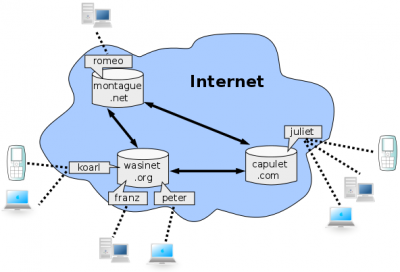Kopete/Jabber/About Jabber XMPP: Difference between revisions
Marked this version for translation |
m fix tag and Internet |
||
| Line 3: | Line 3: | ||
<!--T:1--> | <!--T:1--> | ||
[http://en.wikipedia.org/wiki/XMPP XMPP] or Jabber (these words actually mean the same) is the name of an open, decentral network protocol which is used for instant messaging. It is designed as a server-client-infrastructure with many servers all over the | [http://en.wikipedia.org/wiki/XMPP XMPP] or Jabber (these words actually mean the same) is the name of an open, decentral network protocol which is used for instant messaging. It is designed as a server-client-infrastructure with many servers all over the Internet, where everyone can get an account. The [http://en.wikipedia.org/wiki/Server_%28computing%29 servers] are normally connected to many [http://en.wikipedia.org/wiki/Client_%28computing%29 clients] on one side and to other XMPP-servers of the Internet on the other side. Let's invent a small example to explain how it's working: | ||
<!--T:2--> | <!--T:2--> | ||
| Line 29: | Line 29: | ||
<!--T:9--> | <!--T:9--> | ||
<hr> | <hr /> | ||
{{Prevnext|Special:myLanguage/Kopete/Jabber|Special:myLanguage/Kopete/Jabber/First_steps|Return to index|Page 2 - First steps}} | {{Prevnext|Special:myLanguage/Kopete/Jabber|Special:myLanguage/Kopete/Jabber/First_steps|Return to index|Page 2 - First steps}} | ||
[[Category:Internet]] | [[Category:Internet]] | ||
</translate> | </translate> | ||
Latest revision as of 20:14, 1 December 2010
XMPP or Jabber (these words actually mean the same) is the name of an open, decentral network protocol which is used for instant messaging. It is designed as a server-client-infrastructure with many servers all over the Internet, where everyone can get an account. The servers are normally connected to many clients on one side and to other XMPP-servers of the Internet on the other side. Let's invent a small example to explain how it's working:
Romeo loves Juliet and wants to communicate with her through the Jabber network. He can write messages from his client (which is connected with montague.net) to his girlfriend, whose client is connected to a server called capulet.com.
When he registered an account on a server, he chose a so-called JID (Jabber-Identifier). This JID works basically like an E-Mail-Address and is connected to the server's name with an "@". An example for Romeo's valid JID is [email protected].
In order to talk to other people, Romeo has to add their JIDs to his contact list. They may be connected to the same server (e.g. [email protected]) as well as they can originate from another server (e.g. [email protected] or, of course, [email protected]).

Jabber/XMPP is of course capable of a lot more services (e.g. end-to-end encryption of the messages, voice- and videochat, groupchat), which the tutorial will partly introduce later.
Two very big instant messaging providers use Jabber/XMPP on their servers in the background: Google Talk and facebook chat. Accounts within these systems can be used just like normal Jabber accounts in Kopete. Details will be explained later or can be found at these provider's websites.
With this information we can begin with the main part tutorial: How to set up a working jabber-client and which nice features Kopete has got.
- ← Return to index
- Kopete/Jabber/About Jabber XMPP
- Page 2 - First steps →
